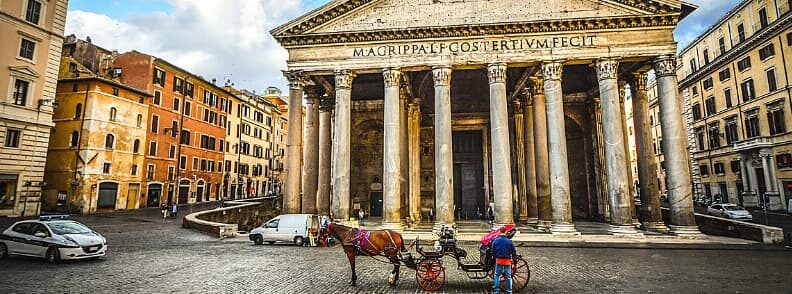Although we started the third day of our Rome holiday early, it was less intense than our second day. However, it was every bit as wonderful. After all, we were about to explore some more of Rome’s historical center!
The historic center of Rome is also known as the Centro Storico. Ancient history and cultural legacy are abundant in Rome’s historic center. The Colosseum, the Pantheon, and the Trevi Fountain are just a few of the famous sites in Rome that are located in the historical centre of Rome.
The old center of Rome offers more than just a collection of well-known attractions, though. It is a vibrant, active neighborhood with winding cobblestone lanes, hopping piazzas, and tucked-away spots just waiting to be found.
The plan was to start with the Pantheon. But, surprise-surprise, we set off to conquer Rome too early and the Pantheon was still closed! So we had some time to slowly wake up and truly become all bright-eyed and bushy-tailed.
Where is the historic center of Rome?
Between the Tiber River and the old Roman walls, in the middle of the city, is where you’ll find the historical center of Rome. The Campo de’ Fiori, the Pantheon, and the Trastevere area are just a few of its neighborhoods. The old center of Rome is home to some of the city’s most well-known structures, including the Colosseum, the Roman Forum, and the Trevi Fountain.
Many of Rome’s most significant cultural institutions, like the buildings of the National Museum of Rome, are also located in the city’s historic center. With its winding cobblestone alleyways, crowded piazzas, and rich history dating back to the Roman Empire, it’s a dynamic and busy area of the Italian capital city.
When was Rome in its prime?
The Roman Empire, which lasted from around 27 BC to 476 AD, was at its peak when Rome itself was in its prime. Rome rose to become one of the most significant and influential cities in history. It had the Colosseum and the Pantheon, two of the most well-known structures and landmarks in the ancient world. It was a hub of art, culture, and politics.
Rome’s prime came to an end with the collapse of the Roman Empire in 476 AD, and the city experienced a time of decline and political unrest. However, as the Italian capital city, Rome continues to be a significant hub for culture and history.
What to see and do in the historical centre of Rome
Ancient history and cultural legacy are abundant in Rome’s historic center. It’s the ideal destination for any traveler wishing to discover authentic Rome with its winding cobblestone lanes, bustling pizzerias, and famous attractions.
However, choosing what to visit in Rome’s old part might be difficult because there is so much to see and do. To help you make the most of your stay in this intriguing area of the city, I’ve put up this guide, based on our own itinerary:
Have breakfast by Piazza della Rotonda in Rome’s historical center
We had skipped breakfast, thinking we could have something to eat after visiting the Pantheon.
With all the free time available, we decided to look for a nice place in the area. We wanted to munch on something while dripping some delicious caffeine into our veins.
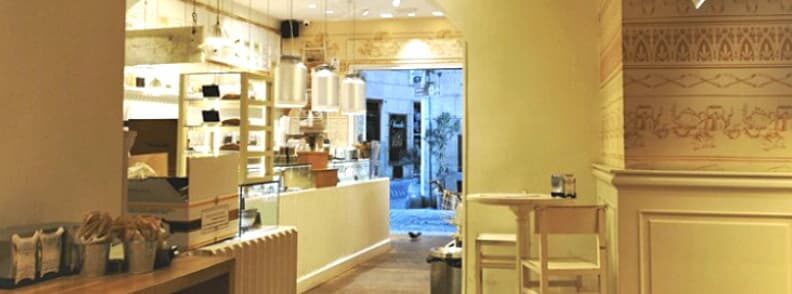
Right by the Piazza della Rotonda, we found a place called Don Nino. This spot was very cozy and had delicious croissants and coffee. Just what we needed!
On our way out, I noticed there was no line to the Pantheon. And there was this sign on a side street saying Fontana di Trevi – 20 minutes. Since we don’t like crowds that much, I figured we could catch the Fontana di Trevi area (almost) entirely empty.
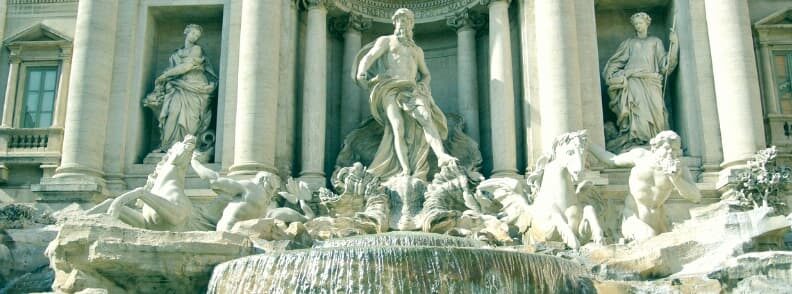
Fontana di Trevi
One of the most recognizable fountains in the world is the Fontana di Trevi. Stone travertine was used to create the fountain, which was finished in 1762. Its height and width are around 26 meters (85 feet) and 49 meters (160 feet), respectively. Sculptures representing mythological characters, such as the deity Oceanus and his chariot drawn by Tritons and horses, embellish the Trevi Fountain.
According to legend, if you toss a coin into Fontana di Trevi, you will travel back to Rome. Due to this, travelers frequently toss coins into the fountain. It’s estimated that every day, more than 3,000 euros are gathered this way. The city collects the coins regularly and uses them to fund charitable actions for the less fortunate residents of Rome.
I guessed right: there was almost nobody in sight at Fontana di Trevi that early! It was not completely free of people, though. Because let’s face it, it’s one of those places in Rome’s historical center where there are always tourists, no matter the hour. This was not La dolce vita, but it was as sweet as it can get!
We looked around, threw our coins, and took some really bad selfies. We don’t usually take selfies, so we lack the practice and we’re kind of against selfie sticks, too.
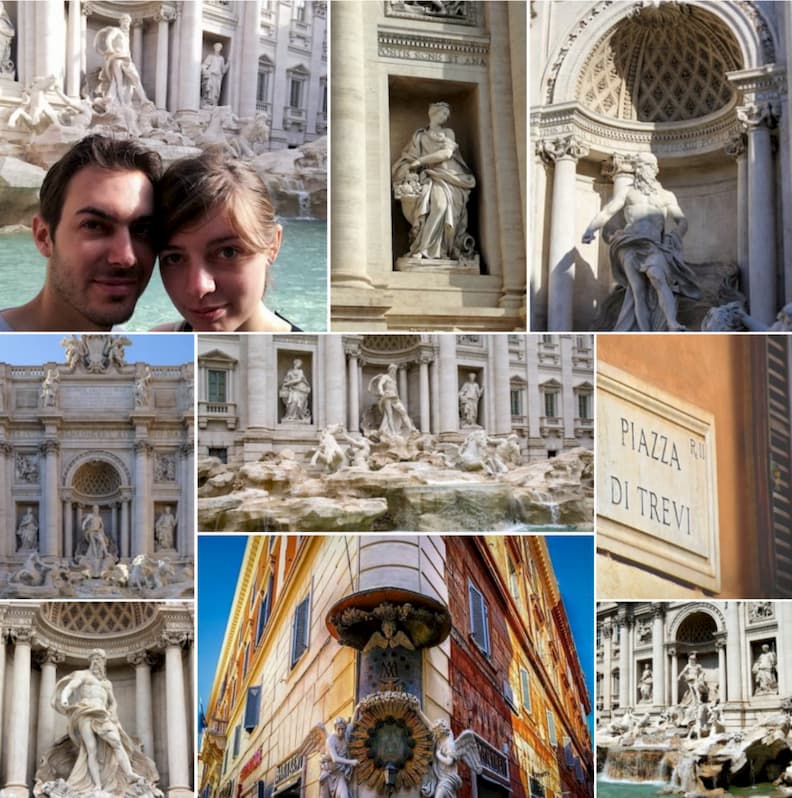
But mornings are difficult when you wake up as early as we did! Right after we left Fontana di Trevi, heading to the Pantheon, I realized the button of my dress had come undone at the back, but we weren’t going to repeat the photos just for that.
The Pantheon
The Pantheon is a historic Roman temple that was finished in the year 126 AD. A mausoleum for significant Italian people, the Pantheon was formerly constructed as a temple to the gods of Ancient Rome. A portico of large granite Corinthian columns supports the circular exterior of the Pantheon.
Inside, the Pantheon has a dome-shaped roof with a central aperture, called an oculus, through which light enters the structure. This dome is one of the world’s most remarkable architectural achievements because its height is equal to its diameter.
Furthermore, the floor of the Pantheon is curved, so that when rainwater falls through the oculus, it doesn’t collect or make puddles. Instead, it goes towards the margins of the circular buildings to be evacuated.
I was especially looking forward to taking Mathieu to see the Pantheon. He truly enjoys studying how things are built, so he was interested in the ceiling and floor.
The entire interior of the Pantheon is breathtaking, to be honest. The reason this ancient pagan temple is so well-preserved? The Pantheon become a church in the year 609 AD. Changing its purpose meant keeping the masterpiece alive to this day. It’s no wonder that this UNESCO World Heritage Site is a popular tourist attraction in the historic centre of Rome.
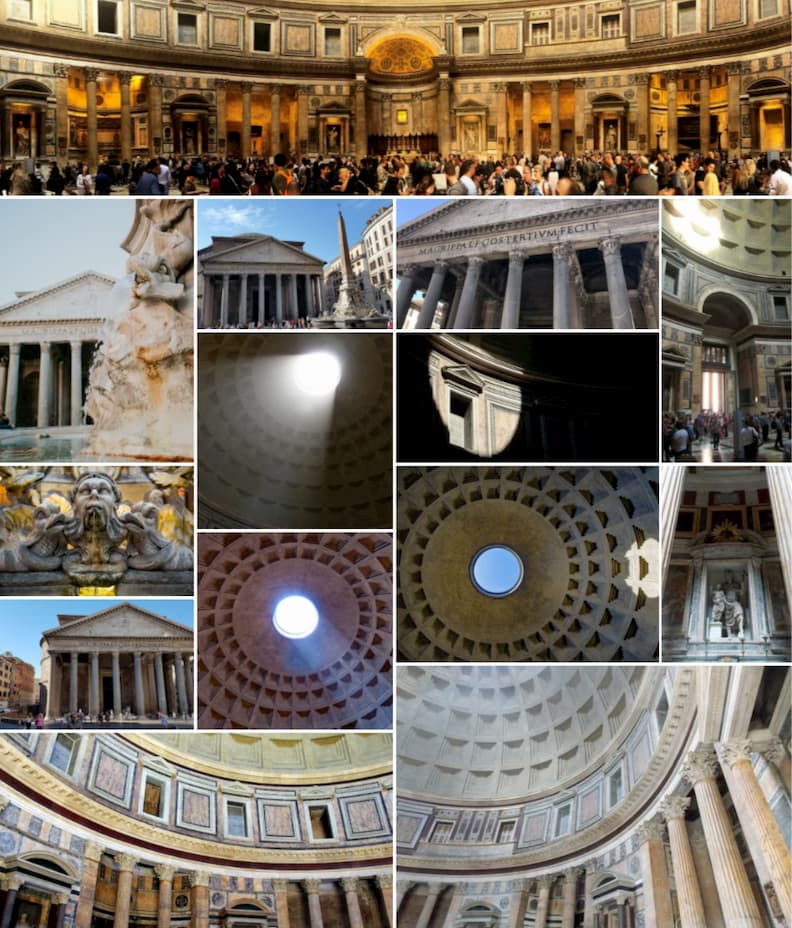
Outside, in Piazza della Rotonda, in front of the Pantheon, we have the Fontana del Pantheon. Sculpted out of marble by Leonardo Sormani in 1575, this fountain in the heart of Rome’s historical center stands high thanks to the later addition of Ramses’s obelisk, in 1711.
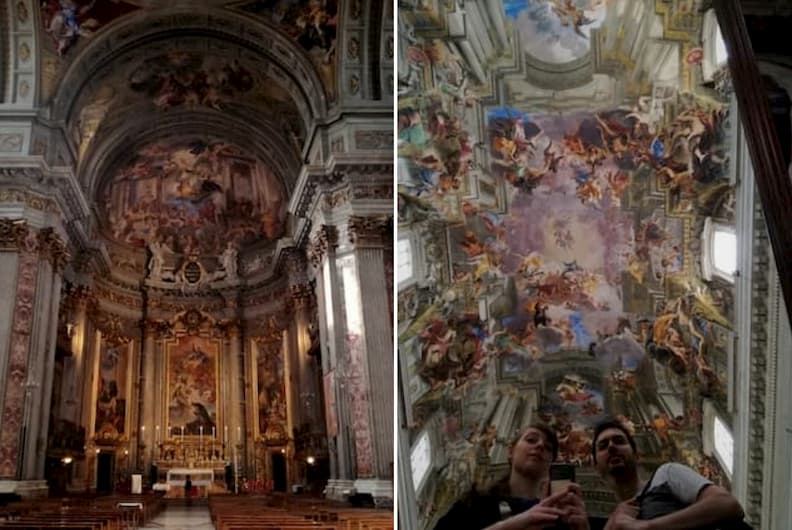
Chiesa di Sant’Ignazio di Loyola
A bit later, we arrived at the lovely Piazza di Sant’Ignazio. There, we wanted to visit one other work of art which I considered interesting for Mathieu. I’m speaking about Chiesa di Sant’Ignazio di Loyola, in Rome’s historical center. The church is famous for two absolutely amazing trompe l’oeil frescoes.
One is the stunning ceiling which can be easily admired in a well-positioned huge mirror. And the second is the dome, which is actually an optical illusion.
Both works belong to Andrea Pozzo.
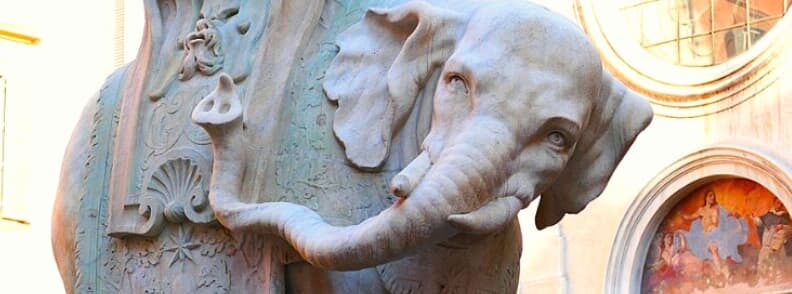
Piazza della Minerva
Not far from Piazza Sant’Ingazio, we have Piazza della Minerva. In its middle, there is the Elephant and Obelisk monument. The baby elephant is the work of Bernini, while the obelisk comes from the excavations of the Temple of Isis (Iseum). It’s sitting right in front of the entrance of a famous basilica.
Basilica Santa Maria Sopra Minerva’s tombs and artwork, which include a Michelangelo figure of St. Catherine of Alexandria, make it the only Gothic church in Rome. The current church was finished in the 13th century, and it was raised on the remains of an older Minerva temple.
The Basilica of Santa Maria Sopra Minerva is noteworthy for its historical and cultural significance in addition to its architectural and artistic value. It is today a well-liked tourist destination and was formerly the heart of the Dominican order in Rome.
Unfortunately, Basilica Santa Maria Sopra Minerva was under restoration when we visited, unfortunately. But if you’re in Rome’s historical center and you find it open, do go in!

San Luigi dei Francesi
A bit disappointed that we didn’t get to see Basilica Santa Maria Sopra Minerva, we went to San Luigi dei Francesi, the national church of France in Italy.
San Luigi dei Francesi was raised in the 16th century for the French community in Rome. The Calling of St. Matthew, The Inspiration of St. Matthew, and The Martyrdom of St. Matthew are three of Caravaggio’s paintings that are featured in this church dedicated to Saint Louis of Toulouse. These artworks are regarded among Caravaggio’s finest and they’re the main attraction for visitors to the cathedral.
I think I should get extra brownie points for taking a French guy called Mathieu to see all this!

Basilica di Sant’Agostino
Almost around the corner from San Luigi dei Francesi, you can find Basilica di Sant’Agostino, one of the first churches of Rome during the Renaissance.
The early 16th-century church dedicated to St. Augustine of Hippo is famous for the masterpieces of the great Italian Renaissance painters Raphael and Caravaggio. You can admire a series of frescoes by Raphael and Madonna del Loretto, a painting by Caravaggio.
As always, I fell in love with the ceilings.

Palazzo Altemps
After leaving Chiesa di Sant’Agostino we found ourselves right next to Palazzo Altemps. Because it was getting very hot outside and we had plenty of time to spare before lunch, we decided to visit the National Roman Museum. And, when acquiring the ticket we got the ones that also included Palazzo Massimo alle Terme, the Baths of Diocletian, and Crypta Balbi. We chose to visit the others on different days, though.
We found Palazzo Altemps to be a jewel itself, with many of the murals and original ceilings well-preserved, at least in part. And its exhibits were interesting, too, combining the old and the new. A must-see in Rome’s historical center!

Wandering on the streets of Rome’s historical center
At the end of our visit to Palazzo Altemps, we felt better being outside, so we wandered on the streets of Rome once more.
Like Mathieu kept saying, what’s great about Rome is that even though you’re in a huge city, every time you get lost on the streets you have the feeling you’re in a small town. And as you move from one Rione to another it’s as if you’re discovering a new village each time.

Campo de’ Fiori
Our wandering around Rome’s historical center eventually led us to Campo de’ Fiori, in Rione Regola.
Campo de’ Fiori is a well-liked tourist destination and a lively marketplace noted for its nightlife and outdoor market. The area, which was previously used only for flower sales, is flanked by structures from the 14th and 15th centuries. A monument of the philosopher Giordano Bruno, who was executed there in 1600, stands in the middle of the rectangle.
We found Rome’s old flower marked nice, but considering how everybody kept telling us to go see it, we had higher expectations. Personally, I didn’t even remember it from my previous Roman holiday. Just like the old bazaar in Bitola, it’s not much different from the markets I see at home.
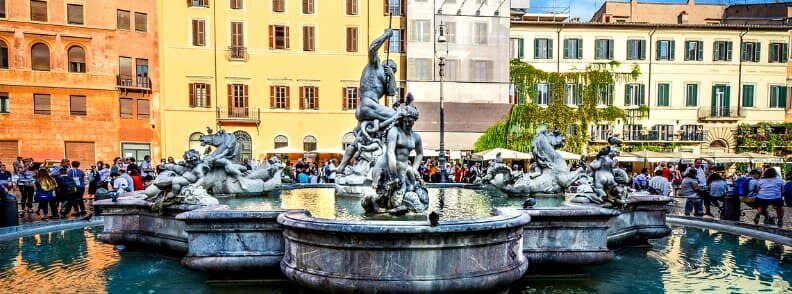
One of Rome’s busiest squares, Piazza Navona is famous for both its historical and aesthetic value. It has buildings from the 17th and 18th centuries and, right in the middle of the square, you can admire the Fountain of the Four Rivers, by Gian Lorenzo Bernini. The Sant’Agnese in Agone church, which Francesco Borromini designed, is also located here. Popular with both locals and travelers, Piazza Navona is famed for its outdoor cafés and street entertainers.
In contrast to Campo de’ Fiori, I remembered Piazza Navona quite well from ten years ago. Although the Fontana dei Quattro Fiumi was under restoration back then, the Piazza was no less impressive. It was beautiful, imposing, and clean.
During the previous holiday, I was traveling with my parents and a friend of mine, Elena. My parents took us to Tre Scalini where we outraged the waiter when the two of us asked for pizza (Signorina, this is a restaurant! We don’t serve pizza here!). We decided to go with the lasagna and annoyed the waiter once again because we were feeding a pigeon with some breadcrumbs.
I also remember sitting with my dad on a bench in Piazza Navona, in Rome’s historical center, next to a nun. And she was speaking Italian and he was speaking Romanian, but they understood each other and had quite a long conversation.
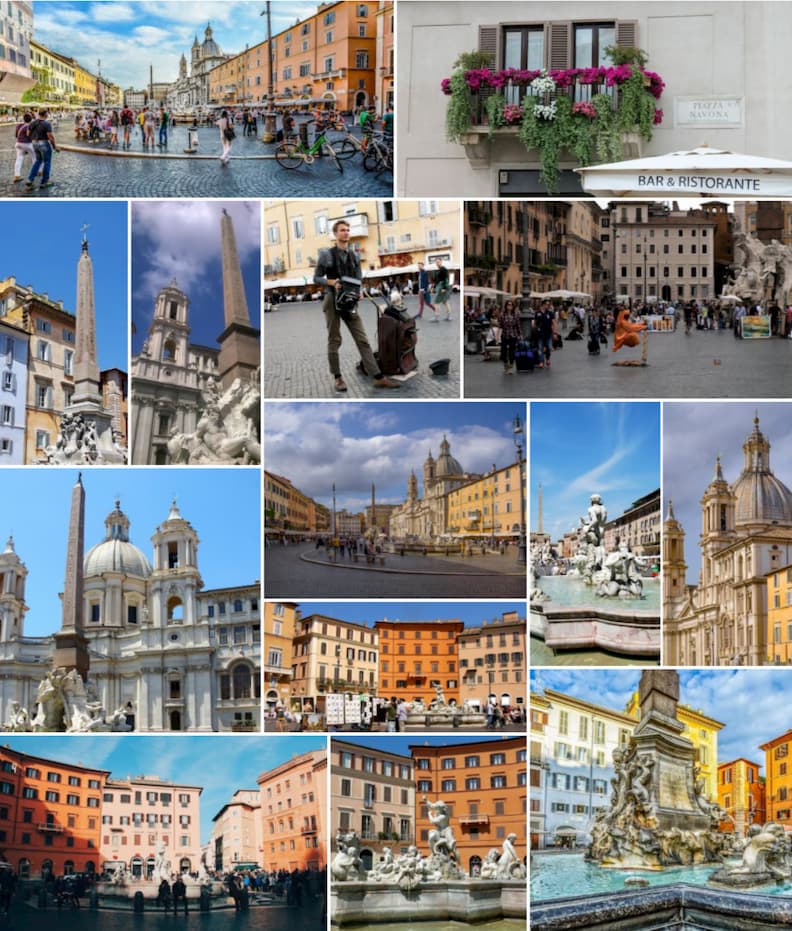
This time, while I was happy to finally see the Fontana dei Quattro Fiumi unveiled, Piazza Navona looked less impressive. It was crowded with tourists and it didn’t look clean anymore. It turned into this commercial area, with lots of merchants, and several terraces on the sides.
I checked out Tre Scalini, probably the most famous restaurant in Rome’s historical center, and its dusty umbrellas didn’t look as inviting as they did years ago. They might still be famous for their Tartufo, but going to an overpriced restaurant just for that didn’t really seem worth it, given the bitter taste I had from this comparison.
So we headed out to have lunch at Da Tonino instead.

Pasta and tiramisu at Da Tonino in Rome’s historical center
When we got to Da Tonino we made it just in time to get a table. It’s very crowded inside and all the surface is used to the maximum to fit tables and chairs.
The staff is extremely friendly, and our waiter suggested some pasta we should try. It was a really good choice. They looked and tasted amazing. So amazing that the lady sitting at the table next to us with several plates in front of her had to ask us about how they were. Don’t get me wrong, she was a fit lady, who really adored Italian food and enjoyed trying everything.
What was funny was that she spoke to the waiter in French. And when she talked to Mathieu, she spoke in English until I pointed out that they could have a conversation in French.
Back to the food, after finishing our pasta and most of our wine, we asked for dessert. And this is when Mathieu began his quest of trying the tiramisu everywhere we went to eat from then on. I’ll be honest, the competition was fierce right from the start, as Da Tonino’s set a high standard with their homemade tiramisu. The best tiramisu I had until then. And so pretty, too!
Once again, we got really lucky with our timing. When we left, there were small groups of people in front of Da Tonino and across the street, waiting for a table to become available. In my opinion, Da Tonino is the best restaurant in Rome’s historical center, so do try to get lunch there.
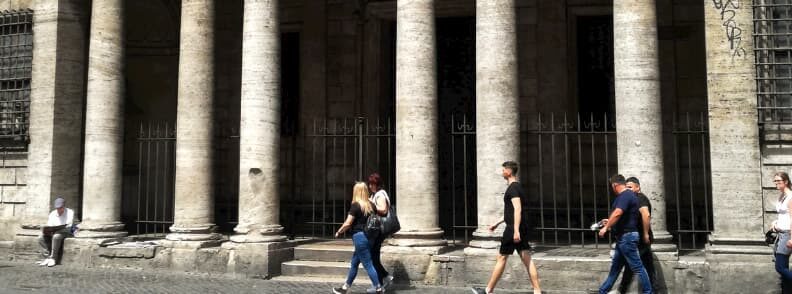
Palazzo Massimo alle Colonne
After having a delicious lunch at Da Tonino, we went down Via del Governo Vecchio to Palazzo Massimo alle Colonne in Rome’s historical center. It is a Renaissance palace by Baldassarre Peruzzi on the site of three palaces that burned down in 1527. The palaces belonged to the Massimo family (old Roman family), hence the name.
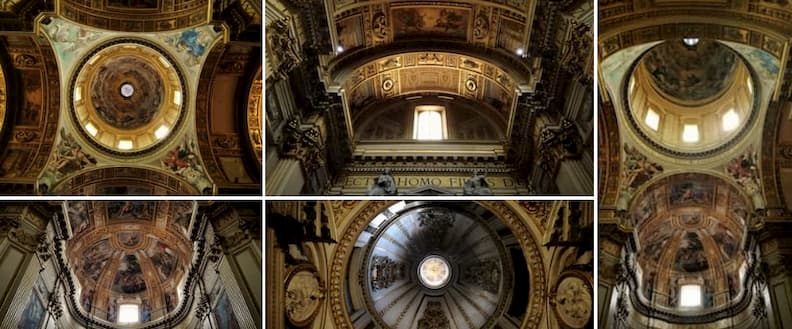
Sant’Andrea della Valle
By now, the heat had caught up with me and I was feeling kind of dizzy. I went across the street from Palazzo Massimo alle Colonne and sat on some stairs, in the shadow. Mathieu suggested we went inside the church at the top of the stairs, where it should be cooler and maybe I’ll start feeling better.
I spent a lot of time sitting down, and just looking at my feet until I felt good enough to start looking around with Mathieu. It was really impressive, though we found the baby Jesus doll a bit creepy. It was only when we were exiting the church that we realized we had visited Sant’Andrea della Valle, from the Rione Sant’Eustachio.
Sant’Andrea della Valle, which was built between the sixteenth and seventeenth centuries, is renowned for both its Baroque architecture and the works of prominent Italian painters, including Caravaggio and Bernini. St. Andrew is honored at the basilica, which also serves as the headquarters of the Archconfraternity of the General Confession. Additionally, this basilica serves as the backdrop for the last act of Giacomo Puccini’s opera Tosca.
Though I was feeling a bit better, we chose to go back and take a nap before moving on with our explorations in Rome’s historical center.
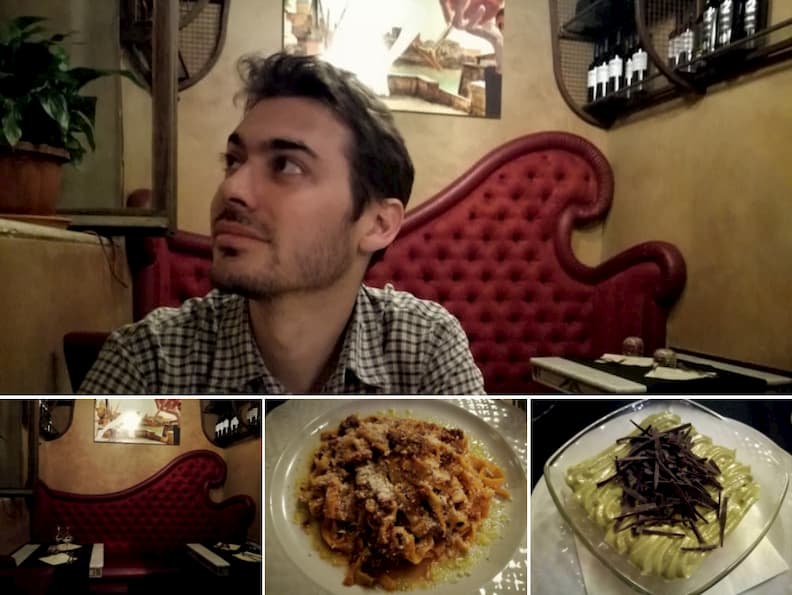
Wining and dining at Verso Sera in Rome’s historical center
We returned to the center of Rome after nightfall, quite hungry. The plan was to eat at Dar Filettaro, but it was full of people outside. And Mathieu isn’t that big a fan of fish, anyway.
We started looking for a different place to eat and came across Hostaria Costanza. There, we went to talk about a table with a guy who was placing some coquilles Saint-Jacques on a platter while telling us it was very difficult to find something at that time in Rome’s historical center without a reservation. He finished what he was doing, had a look, and told us sorry, but no.
I was getting really hungry and everywhere was completely full. And then we saw this place with some cute fairy lights outside. Mathieu said to try there, too, but I was all: no, it looks really nice, there’s no way we’ll find something there!
But he tried. And that’s how we got to have dinner at Verso Sera Rome. And while I was waiting for the other shoe to drop and find something wrong with the place because we were able to get a table, I just couldn’t. It looked incredible inside, they had lots of wine options and they served it by the book.
And the food! We had pasta again and it was delicious. (Yes, from pizza-pizza-pizza we went to pasta-pasta-pasta.) And, for dessert, no tiramisu, but we found the next best thing: pistachio mousse.
We are very happy to have found Verso Sera in Rome’s historical center. We recommend it with all our hearts should you ever find yourself hungry and close to Campo de’ Fiori.
A fun evening in Rome’s historical center
Speaking of Campo de’ Fiori, we caught a band playing covers on the street (mostly rock). They were very good and charismatic and gathered quite a big crowd. It was really nice to see people from all over the world singing and dancing in the street, together.
We went back home in a very good mood. Day 3 spent uncovering Rome’s historical center was wonderful and we couldn’t wait for the next one. Especially since the intense part of our holiday was kind of over and the rest was a lot more relaxed and with a lot more room for just winging it.
Come discover the wonders of Rome’s historical center
The historical center is a great location to start whether you are interested in history or culture, or simply want to see how genuine Rome is. This exciting and intriguing area of the city has something for everyone, from the old majestic basilicas to the thriving nightlife and surprising street performances.

Mirela Letailleur is a Romanian travel blogger living in the South of France. She writes on The Travel Bunny travel blog about affordable travel in Europe, creator of unique free travel guides, local travel expert. Problem solver. Wannabe coffee guru.
Enjoyed uncovering Rome’s historical center? You’ll love these articles:
Colosseum, Roman Forum & Palatine Hill
Walking from Vatican City to Trastevere
Discovering Rome’s piazzas

